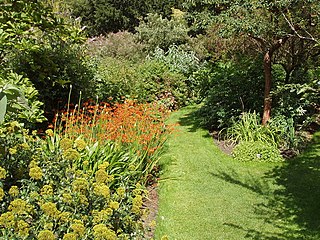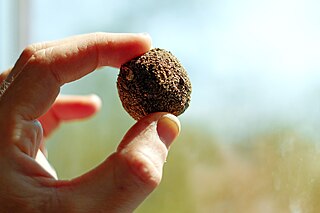 W
WA seed is an embryonic plant enclosed in a protective outer covering. The formation of the seed is part of the process of reproduction in seed plants, the spermatophytes, including the gymnosperm and angiosperm plants.
 W
WAerial seeding is a technique of sowing seeds by spraying them through aerial mechanical means such as a drone, plane or helicopter.
 W
WBioprospecting is the exploration of natural sources for small molecules, macromolecules and biochemical and genetic information that could be developed into commercially valuable products for the agricultural, aquaculture, bioremediation, cosmetics, nanotechnology, or pharmaceutical industries. In the pharmaceutical industry, for example, almost one third of all small-molecule drugs approved by the U.S. Food and Drug Administration (FDA) between 1981 and 2014 were either natural products or compounds derived from natural products.
 W
WIn agriculture, gardening, and forestry, broadcast seeding is a method of seeding that involves scattering seed, by hand or mechanically, over a relatively large area. This is in contrast to:precision seeding, where seed is placed at a precise spacing and depth; hydroseeding, where a slurry of seed, mulch and water is sprayed over prepared ground in a uniform layer.
 W
WChia seeds are the edible seeds of Salvia hispanica, a flowering plant in the mint family (Lamiaceae) native to central and southern Mexico, or of the related Salvia columbariae of the southwestern United States and Mexico. Chia seeds are oval and gray with black and white spots, having a diameter around 2 millimetres (0.08 in). The seeds are hygroscopic, absorbing up to 12 times their weight in liquid when soaked and developing a mucilaginous coating that gives chia-based foods and beverages a distinctive gel texture.
 W
WThe Federal Seed Act, P.L. 76-354, requires accurate labeling and purity standards for seeds in commerce, and prohibits the importation and movement of adulterated or misbranded seeds. The law works in conjunction with the Plant Protection Act of 2000 to authorize the Animal and Plant Health Inspection Service (APHIS) to regulate the importation of field crop, pasture and forage, or vegetable seed that may contain noxious weed seeds. USDA's Agricultural Marketing Service is responsible for enforcing the labeling and purity standard provisions.
 W
WGermination is the process by which an organism grows from a seed or spore. The term is applied to the sprouting of a seedling from a seed of an angiosperm or gymnosperm, the growth of a sporeling from a spore, such as the spores of fungi, ferns, bacteria, and the growth of the pollen tube from the pollen grain of a seed plant.
 W
WThis is an alphabetical list of plants used in herbalism.
 W
WMyrmecochory is seed dispersal by ants, an ecologically significant ant-plant interaction with worldwide distribution. Most myrmecochorous plants produce seeds with elaiosomes, a term encompassing various external appendages or "food bodies" rich in lipids, amino acids, or other nutrients that are attractive to ants. The seed with its attached elaiosome is collectively known as a diaspore. Seed dispersal by ants is typically accomplished when foraging workers carry diaspores back to the ant colony, after which the elaiosome is removed or fed directly to ant larvae. Once the elaiosome is consumed, the seed is usually discarded in underground middens or ejected from the nest. Although diaspores are seldom distributed far from the parent plant, myrmecochores also benefit from this predominantly mutualistic interaction through dispersal to favourable locations for germination, as well as escape from seed predation.
 W
WNickernuts or nickar nuts are smooth, shiny seeds from tropical leguminous shrubs, particularly Guilandina bonduc and Guilandina major, both known by the common name warri tree. C. bonduc produces gray nickernuts, and C. major produces yellow. Accordingly, these species are locally known in the Caribbean as "grey nickers" and "yellow nickers".
 W
WThere are several candidates for the oldest viable seed:
 W
WOrthodox seeds are seeds which will survive drying and/or freezing during ex-situ conservation, as opposed to recalcitrant seeds, which will not. According to information from the U.S. Department of Agriculture, there is variation in the ability of orthodox seeds to withstand drying and storage, with some seeds being more sensitive than others. Thus some seeds are considered intermediate in their storage capability while others are fully orthodox. One notable example of a long-lived orthodox seed which survived accidental storage followed by controlled germination is the case of the 2,000-year-old Judean date palm seed which successfully sprouted in 2005. This particular seed is reputed to be the oldest viable seed, but the upper survival time limit of properly stored seeds remains unknown.
 W
WProvenance is the chronology of the ownership, custody or location of a historical object. The term was originally mostly used in relation to works of art but is now used in similar senses in a wide range of fields, including archaeology, paleontology, archives, manuscripts, printed books, the circular economy, and science and computing.
 W
WRecalcitrant seeds are seeds that do not survive drying and freezing during ex-situ conservation. By and large, these seeds cannot resist the effects of drying or temperatures less than 10 °C ; thus, they cannot be stored for long periods like orthodox seeds because they can lose their viability. Plants that produce recalcitrant seeds include avocado, mango, mangosteen, lychee, cocoa, rubber tree, some horticultural trees, aquatic plants, such as Nymphaea caerulea, and several plants used in traditional medicine, such as species of Virola and Pentaclethra. Generally speaking, most tropical pioneer species have orthodox seeds but many climax species have recalcitrant or intermediate seeds.
 W
WSeed balls, also known as earth balls or nendo dango , consist of a variety of different seeds rolled within a ball of clay, preferably volcanic pyroclastic red clay. Various additives may be included, such as humus or compost. These are placed around the seeds, at the center of the ball, to provide microbial inoculants. Cotton-fibres or liquefied paper are sometimes mixed into the clay in order to strengthen it, or liquefied paper mash coated on the outside to further protect the clay ball during sowing by throwing, or in particularly harsh habitats.
 W
WA seed bank stores seeds to preserve genetic diversity; hence it is a type of gene bank. There are many reasons to store seeds. One is to preserve the genes that plant breeders need to increase yield, disease resistance, drought tolerance, nutritional quality, taste, etc. of crops. Another is to forestall loss of genetic diversity in rare or imperiled plant species in an effort to conserve biodiversity ex situ. Many plants that were used centuries ago by humans are used less frequently now; seed banks offer a way to preserve that historical and cultural value. Collections of seeds stored at constant low temperature and low moisture are guarded against loss of genetic resources that are otherwise maintained in situ or in field collections. These alternative "living" collections can be damaged by natural disasters, outbreaks of disease, or war. Seed banks are considered seed libraries, containing valuable information about evolved strategies to combat plant stress, and can be used to create genetically modified versions of existing seeds. The work of seed banks spans decades and even centuries. Most seed banks are publicly funded and seeds are usually available for research that benefits the public.
 W
WSeed dispersal is the movement, spread or transport of seeds away from the parent plant. Plants have limited mobility and rely upon a variety of dispersal vectors to transport their propagules, including both abiotic vectors such as the wind and living (biotic) vectors like birds. Seeds can be dispersed away from the parent plant individually or collectively, as well as dispersed in both space and time. The patterns of seed dispersal are determined in large part by the dispersal mechanism and this has important implications for the demographic and genetic structure of plant populations, as well as migration patterns and species interactions. There are five main modes of seed dispersal: gravity, wind, ballistic, water, and by animals. Some plants are serotinous and only disperse their seeds in response to an environmental stimulus. Dispersal involves the letting go or detachment of a diaspore from the main parent plant.
 W
WA seed germinator is a device for germinating seeds. Typically, these create an environment in which light, humidity and temperature are controlled to provide optimum conditions for the germination of seeds.
 W
WA seed orchard is an intensively-managed plantation of specifically arranged trees for the mass production of genetically improved seeds to create plants, or seeds for the establishment of new forests.
 W
WSeed swaps are events where gardeners meet to exchange seeds. Swapping can be arranged online or by mail, especially when participants are spread out geographically. Swap meet events, where growers meet and exchange their excess seeds in person, are also growing in popularity. In part this is due to increased interest in organic gardening and heritage or heirloom plant varietals. This reflects gardeners' interest in "unusual or particular varieties of flowers and vegetables," according to Kathy Jentz of Washington Gardener Magazine (Maryland).
 W
WSurinder Mohan (Suri) Sehgal is an India-born American philanthropist with a long career as a crop scientist, seedsman, entrepreneur, and leading expert in the global hybrid seed industry. His research and professional successes in the areas of plant breeding and genetics, agbiotechnology, intellectual property, business management, and seed industry development were carried out in executive capacities in several companies in the United States, Belgium, and Germany. After the divestment of a group of four seed companies that Sehgal founded and ran with his wife, Edda Sehgal, the couple created two nonprofit organizations to promote rural development in Suri's country of origin: Sehgal (Family) Foundation in 1998 in the US, and S M Sehgal Foundation in India. The foundations’ work focuses on water security, food security, and social justice with particular emphasis on women's empowerment. A proponent of corporate social responsibility and environmental sustainability, Sehgal has also provided support individually and through the foundations for projects related to agriculture research, the preservation of biodiversity and the conservation of natural resources.
 W
WSowing is the process of planting. An area or object that has had seeds planted in it will be described as a sowed area.
 W
W